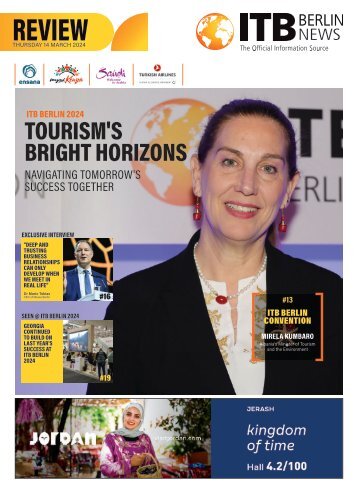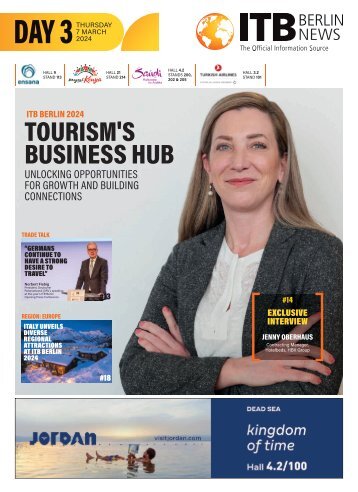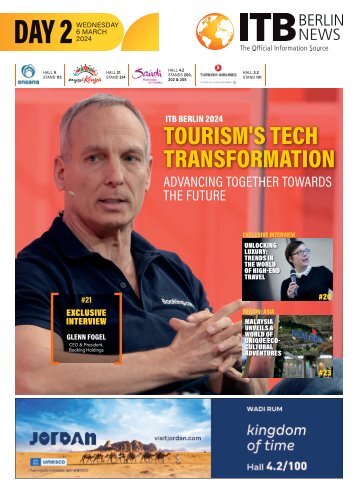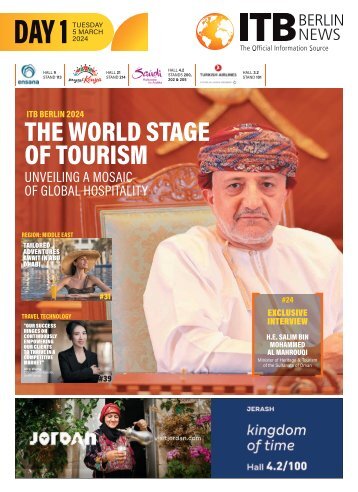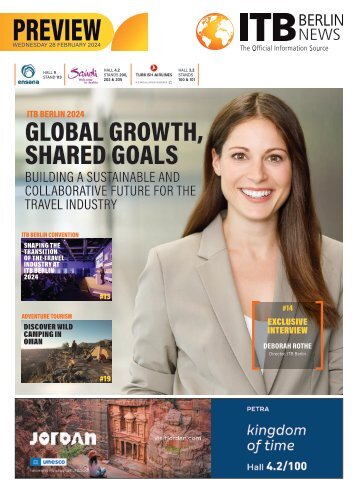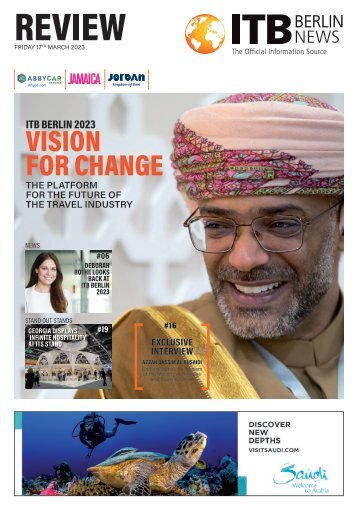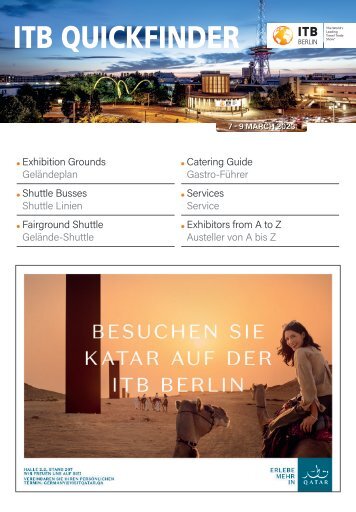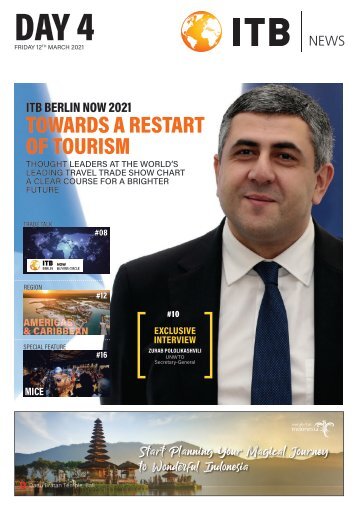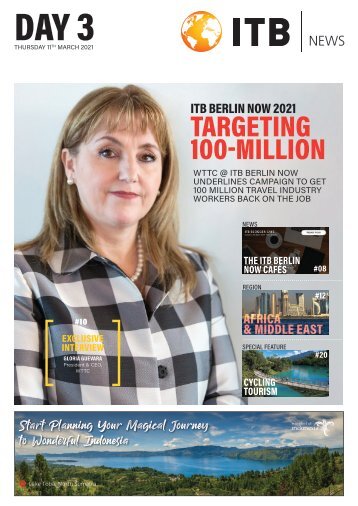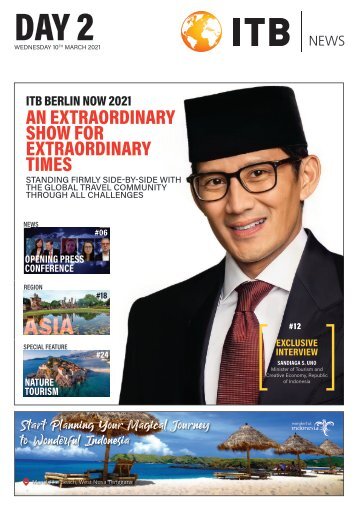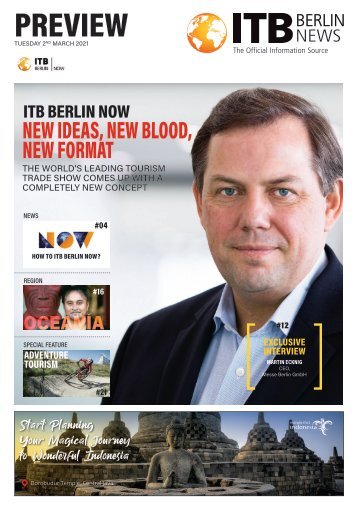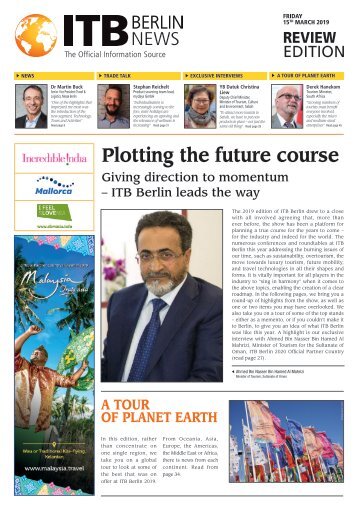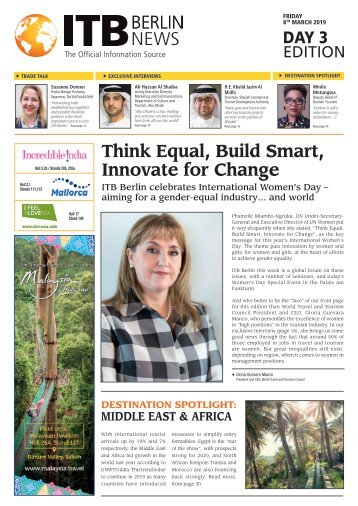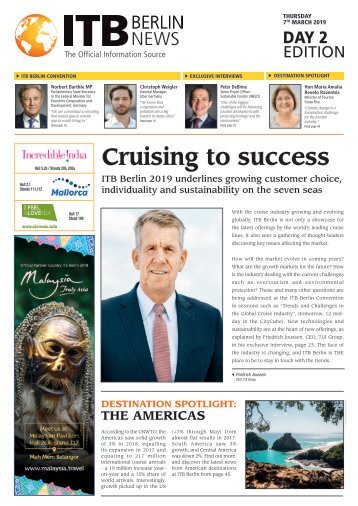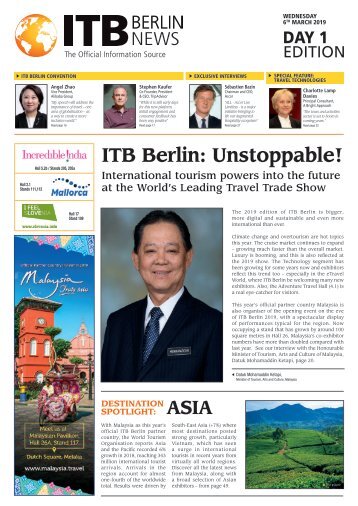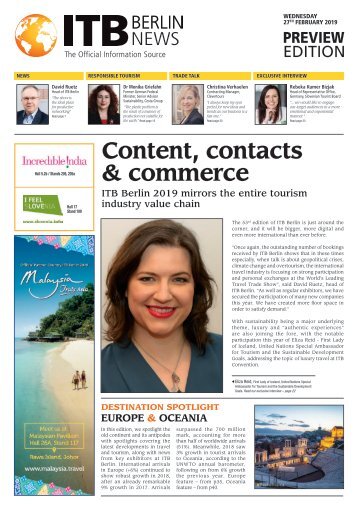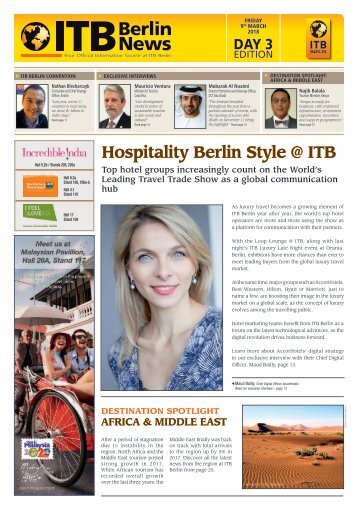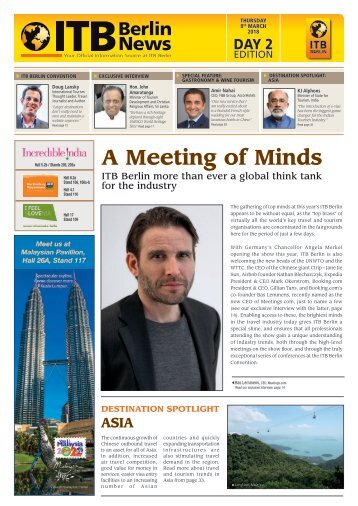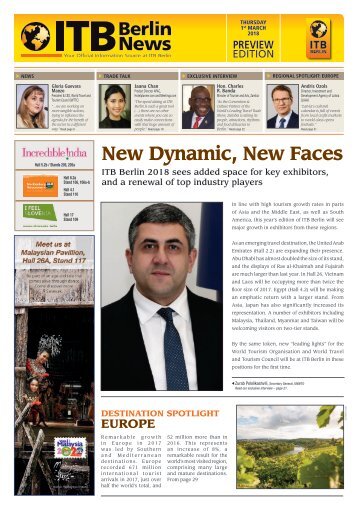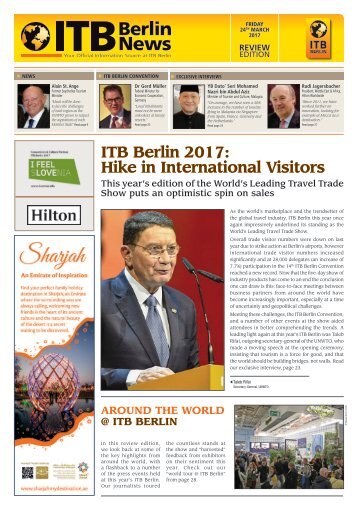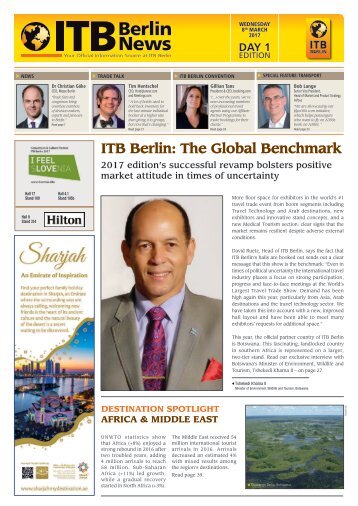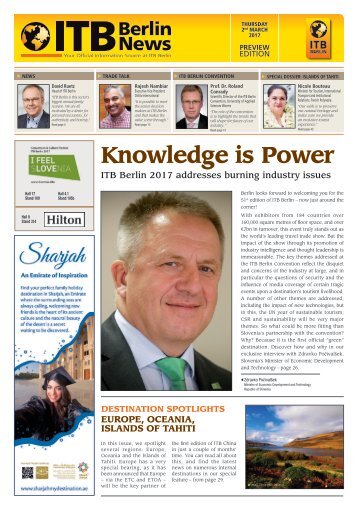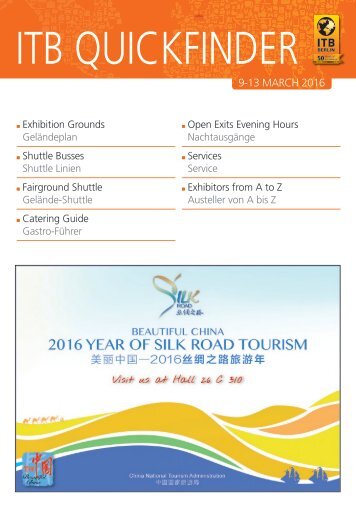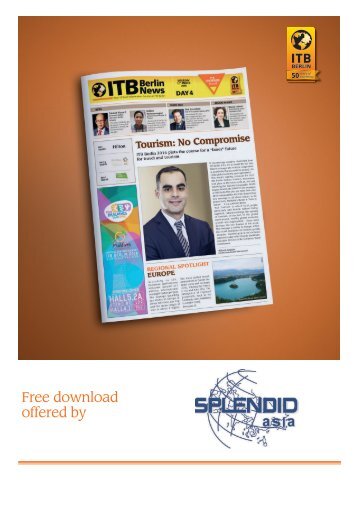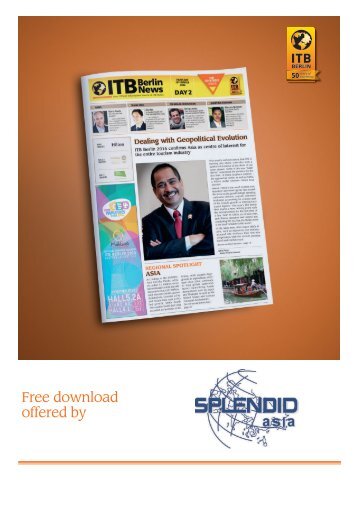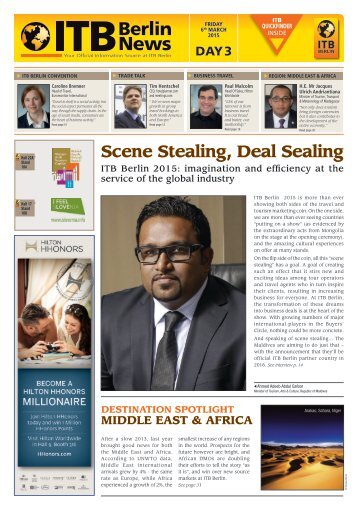
ITB Berlin News - Day 3
- Text
- Berlin
- Tourism
- Destinations
- Destination
- Cultural
- Sharjah
- Region
- Hotels
- Exhibition
- Americas
14 EXCLUSIVE INTERVIEW
14 EXCLUSIVE INTERVIEW “At the Helm” of the World’s Biggest Hotel Group Exclusive Interview: Arne Sorenson – President & CEO – Marriott International Arne Sorenson is now at the helm of the largest lodging company in the world, having taken over the Starwood group. We asked him what the most challenging elements were of “managing the deal of the decade”? Arne Sorenson President & CEO – Marriott International WE ARE GOING TO OPEN A HOTEL A LITTLE BIT MORE OFTEN THAN ONCE EVERY 16 HOURS IN 2017 Let’s put it in context. It is big. We are going to open a hotel a little bit more often than once every 16 hours in 2017, which gives you the scale of the size of this, and of course we need to make sure that those hotels each open as close to flawlessly as possible, and that entails an extraordinary amount of work. It means motivating and empowering people who are set up around the world not from decisions that are made at the centre. I think when you look at the most important things for us to get right, obviously we need to get that day-today stuff right, in addition to the operation of the approximately 6,000 hotels we have operating today. But beyond that we have to make sure we pull together the loyalty programmes – Marriott Rewards and SPG - in a way that causes that community of almost 100-million unique members to like the programme as it evolves going forward and to intensify their loyalty to our portfolio of hotels. Why was it so important to acquire Starwood? It really starts with this loyalty programme. We obviously want to be able to deliver to our customers as broad a range of choices as they can, and we want to be able to say to them, “You really don’t need to look anywhere else when you are thinking about booking a hotel today”. We’ve got tremendous distribution in the luxury area, tremendous distribution in lifestyle, strong distribution in select service. As a consequence, no matter what you want to spend, no matter where you are going, no matter what kind of sensibility you want from the hotel, we have a place for you to stay. And we think we can create an ecosystem of loyal customers who look to us for their place to stay and look to us directly for booking their experience, sharing their experience, planning their travel… we want to be relevant in all those spaces. And we think by being bigger, by having that many more choices, by having that much bigger ecosystem of customers, we create something that is just that much more powerful than we could have done on our own. You were chosen as the first “non-family” president & CEO in the history of the company. What qualities were required to fill this role, and what attracted you to this position? I got to know Mr Marriott in 1992, and have been working with him regularly since 1996. He has taught me an extraordinary amount. In many respects, I think he’s forgotten more about the hotel business than I will ever know. But he remains a good partner, and I think as he got to a point where he needed to hand off the CEO role to somebody else, that relationship we had – the fact that I was a known quantity – were very comforting elements to him. I think beyond that, the things he has taught me and I believe to important would be an open-mindedness and a curiosity about trends in our business, threats to our business – and it’s about keeping your ears open and listening – both to folks internally and to competitors and to other forces that are happening in the marketplace. That open mindedness was very much a feature of his leadership style and I hope it’s one of mine. In addition to that, it is a job that requires an attentiveness to people. We all say this of course, but in no industry is it more true than in ours… we are a people business. We cannot deliver the kind of experience we want our guests to have except through our people. What are your thoughts about ITB Berlin? ITB is one of the globe’s principal gatherings of customers and travel companies – and an indispensable place to do business ITB BERLIN NEWS • Friday 10 th March 2017 www.itb-berlin-news.com
SPECIAL FEATURE CULTURAL TOURISM 15 Central Souq Sharjah Museum of Islamic Civilization The Emirate of Sharjah has long been a magnet for culture enthusiasts seeking a deeper understanding of the civilisation of the Arab region, both traditional and contemporary – and for good reason. From its fairs and festivals to its museums and universities, Sharjah truly holds its own as a cultural capital in the region and is already attracting travellers hungry for culture. No wonder that Sharjah was named the Islamisc Culture Capital in 2014 for its unparalleled contributions to the preservation of heritage and culture. SHARJAH LIGHT FESTIVAL Sharjah’s dedication to preserve its culture can be seen clearly through the traditional Arabian and Islamic architecture that characterises many of its landmarks. In an effort to shed light, quite literally, on that aspect, the emirate organises the now world famous Sharjah Light Festival, whereby landmarks across Sharjah bear threedimensional light displays for ten days each February. Combining local talents and internationally renowned artists, the festival attracts hundreds of thousands of visitors who come to be amazed by the spectacular illumination of the emirate’s inspiring architecture, rich civilization, history and monuments. The Sharjah Light Festival is continuing to grow in prestige as a highly anticipated cultural event in the region that will give holiday-makers more reason to travel to the Arabian Gulf. LITERATURE AND ART Away from architecture, Sharjah throws considerable weight behind art and literature, among other cultural activities. Every November since 1982, the emirate organises the Sharjah International Book Fair (SIBF), a 10-day event that regularly attracts upwards of one million attendees annually (SIBF 2016 welcomed more than 2.31 million visitors, 1,681 publishing houses from 60 countries, with approximately 1.5 million titles on display). One of the largest book fairs in the world, the SIBF is among the most prestigious in the Arab world and the most exciting literary event in the region. In 2013, the respected book industry publication “The Bookseller” named SIBF one of the top four books fairs globally. Also in the literary vein, the American University of Sharjah boasts an 11,000-square- metre library housing a staggering collection of 125,000 Englishlanguage books, as well as literature in other languages – chiefly Arabic. As for art, the Sharjah Art Museum is a three-storey exhibition space showing artworks and collections covering diverse mediums and techniques. The museum not only welcomes visitors daily from 8:00am to 8:00pm (4:00pm to 8:00pm on Fridays), but is free of charge. Throughout the year, the museum houses several temporary exhibitions and art events. The Museum’s Art Library, meanwhile, is home to over 4,000 titles in Arabic, English, and other languages, along with visual and audio materials. EMIRATES HERITAGE Meanwhile, every April, Sharjah Heritage Days celebrates and preserves the customs and traditions of the UAE with a number of cultural activities, workshops, displays, and entertainment. The annual event coincides with UNESCO’S celebrations of Heritage International Day during the month of April, and is aimed at reminding current and future generations of the rich traditions of the past by throwing light on long-established customs, arts and professions in the region. Sharjah Heritage Days will appeal to tourists looking for an authentic expression of unique Emirati culture. The gulf city has also established a dedicated Calligraphy Museum, and holds the Sharjah Art Biennial once every two years (the 13th Sharjah: Arabia’s Culture Lovers’ Capital Travel trade illuminated by Sharjah’s cultural wonders at ITB Berlin edition is set to take place in 2017), as well as the Sharjah Calligraphy Biennial. In over a decade of operation, the Sharjah Calligraphy Museum has collected over 300 works that adorn canvas, wood, paper and ceramics. The assortment includes historic paintings in the Kufic font and, most notably, the Al Hulia Al Sharifa by Iraqi calligrapher Ziad Al Muhandis (measuring 280x300cm and considered the largest in the Islamic world) Hall 2.2 / Stand 102 ITB BERLIN NEWS • Friday 10 th March 2017
- Page 1: FRIDAY 10 th MARCH 2017 DAY 3 EDITI
- Page 4: 4 NEWS ADVERTORIAL Rediscovering Th
- Page 8 and 9: 8 NEWS Turkey Expands Presence, Sho
- Page 11 and 12: TRADE TALK 11 Pleasure Travel Is Ou
- Page 13: ITB BERLIN CONVENTION 13 Jon Barnet
- Page 17: SPECIAL FEATURE CULTURAL TOURISM 17
- Page 20 and 21: 20 SPECIAL FEATURE FAMILY DESTINATI
- Page 22 and 23: 22 REGION AMERICAS © Max Bosio MAI
- Page 24 and 25: 24 REGION AMERICAS Petra Cruz Direc
- Page 26 and 27: 26 REGION AMERICAS Miami Goes the W
- Page 28 and 29: 28 SPOTLIGHT ON GERMAN REGION: BERL
- Page 30: 30 Hospitality WHERE TO GO IN Berli
Inappropriate
Loading...
Embed
Loading...
